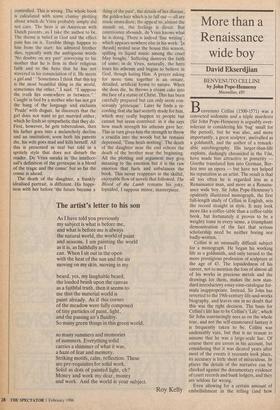More than a Renaissance wide boy
David Ekserdjian
BENVENUTO CELLINI by John Pope-Hennessy
Macmillan, £85
Benvenuto Cellini (1500-1571) was a convicted sodomite and a triple murderer (Sir John Pope-Hennessy is arguably over- tolerant in considering his 'bag' small for the period), but he was also, and more importantly, a great sculptor, unrivalled as a goldsmith, and the author of a remark- able autobiography. His larger-than-life exploits, dashingly chronicled in the Vita, have made him attractive to posterity — Goethe translated him into German, Ber- lioz into an opera — but have not helped his reputation as an artist. The result is that all too often he is regarded less as a Renaissance man, and more as a Renaiss- ance wide boy. Sir John Pope-Hennessy's opulently illustrated monograph, the first full-length study of Cellini in English, sets the record straight in style. It may look more like a coffee-table than a coffee-table book, but fortunately it proves to be a weighty tome in every sense, a triumphant demonstration of the fact that serious scholarship need be neither boring nor badly-written.
Cellini is an unusually difficult subject for a monograph. He began his working life as a goldsmith, and only turned to the more prestigious profession of sculpture at the age of 43. The lopsidedness of his career, not to mention the loss of almost all of his works in precious metals and the drawings for them, makes the now stan- dard introductory essay-cum-catalogue for- mula inappropriate. Instead, Sir John has reverted to the 19th-century life-and-works biography, and leaves one in no doubt that this was the right decision. The basis for Cellini's life has to be Cellini's 'Life', which Sir John convincingly sees as on the whole true, and not the self-enamoured fantasy it is frequently taken to be. Cellini was undeniably vain, but that is no reason to assume that he was a large-scale liar. Of course there are errors in his account, but considering that it was dicated years after most of the events it recounts took place, its accuracy is little short of miraculous. In places the details of the narrative can be checked against the documentary evidence of court records and bank ledgers, and they are seldom far wrong.
Even allowing for a certain amount of embellishment in the telling (and how many good stories are not quietly `im- proved' over the years?), Cellini did lead an exceptionally dramatic life, full of triumphs and disasters, of great loves and even greater hates. His claim to have shot Charles of Bourbon, the leader of the imperial troops, at the sack of Rome appears to be unfounded, but the close encounters with Popes Clement VII and Paul III, with the Emperor Charles V, and Francis I of France actually took place. So, to turn from High Life to Low, did the numerous imprisonments, murders and seductions (no model of either sex seems to have been safe for very long). What is unique, however, rather than simply enter- taining, is the way Cellini writes about his art. The style is no less theatrical, especial- ly in such set-pieces as the virtuoso descrip- tion of the casting of the Perseus, but we also learn quite how hard he had to work to achieve such perfection.
Cellini's fame rests above all on four major works, and they rightly dominate this book, while still leaving ample space for new discoveries, and for evocative passages on such pieces as the charming and ingenious Narcissus, and the busts of Duke Cosimo de'Medici and Bindo Altovi- ti. The first of the four is the gold and enamel Salt-cellar of Francis I, presumably not the sort of thing Nancy Mitford had in mind when she condemned cruets as non- U. It is the finest jewel of Cellini the goldsmith, yet the conception is already monumental, and the figure style owes more than a little to Michelangelo. By contrast, it-is French taste that lies behind the Nymph of Fontainebleau, a bronze relief that artfully combines a sinuously elegant female nude with realistically- observed but poetic animals. In his discus- sion of both these works, and of their original appearance in particular, Sir John never lets technical analysis distract him from their meaning, but instead shows that it is an essential prerequisite to under- standing. Back home in Florence, Cellini created his masterpiece, the Perseus and Medusa, with more than a nod in the direction of Donatello's David as well as Michelangelo, and Sir John is most reward- ing here in his account of the only Cellini project for which a large number of prepa- ratory models survive. Finally, as if to prove he was a real sculptor and not merely a metalworker on a gigantic scale, Cellini carved the Marble Crucifix, a deeply-felt religious image after all the mythology.
Born of a vision he had in prison and originally intended for his own tomb, it is life-size, and so milky-soft that a fellow- sculptor declared he knew not whether it was stone or flesh.
When Francis I was shown the Salt- cellar, he uttered a cry of astonishment and looked at it for a long time. We can probably all manage the cry, but there is more to a great work of art than the first impression. That is why we should be grateful to the Pope, as Sir John is affec- tionately known, for having helped us to look more deeply too.















































 Previous page
Previous page